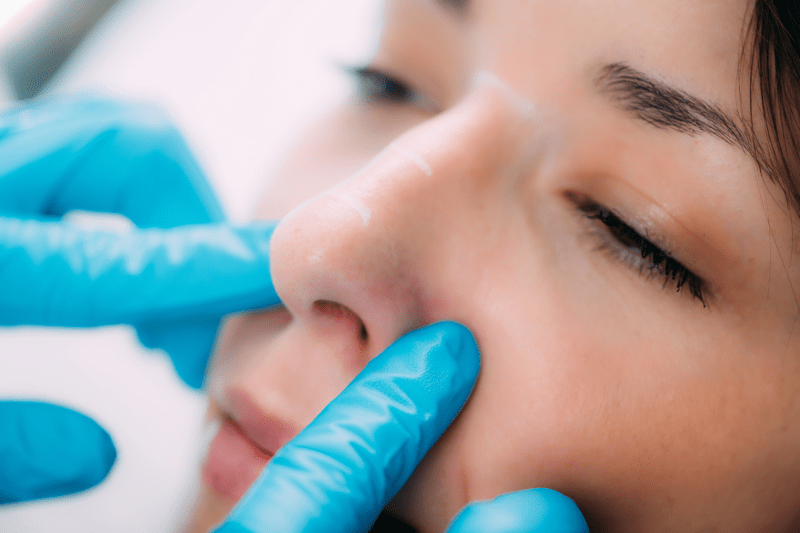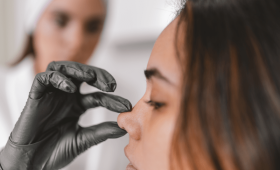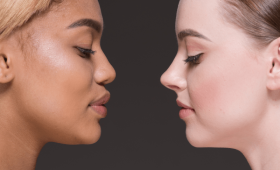What Is Rhinoplasty Surgery And How Is It Performed?
Rhinoplasty is a surgical procedure performed to correct the aesthetic appearance of the nose or to improve nasal function. This surgery aims to permanently eliminate structural issues such as the hump on the nasal bridge, the shape of the nasal tip, the size of the nostrils, or the width of the nasal wings. The procedure can be performed using either the open or closed technique, depending on the patient’s needs and the surgeon’s preference and expertise.
A successful rhinoplasty not only addresses aesthetic concerns but also resolves issues related to the respiratory tract, thereby significantly increasing the overall quality of life. Digital analyses performed before the surgery play a critical role in matching the patient’s expectations with the surgically achievable, realistic outcomes.
What Are The Starting Prices For Rhinoplasty In Kusadasi?
Rhinoplasty prices in Kusadasi vary depending on the complexity of the procedure, the current condition of the nose, and the surgical technique to be applied by the specialist. As is the case across Turkey, prices in Kusadasi are generally at more affordable levels compared to procedures of equivalent quality in Europe and North America, offering great value.
While starting prices are reasonable for a standard primary correction procedure, they may increase significantly for more complex cases such as revision rhinoplasty. Package offers you receive through Cure Holiday cover not only the surgical cost but also additional services such as airport transfers and accommodation, allowing you to clearly budget your expenses from the very beginning of your travel plans.
What Are The Main Factors Affecting The Cost Of Rhinoplasty?
The primary factors influencing the cost of rhinoplasty include the initial degree of nasal deformity and the level of surgical difficulty required to achieve the desired result. For example, there is a significant price difference between a minor nasal tip correction (tip plasty), which only involves soft tissue, and a comprehensive correction that includes the nasal bone, cartilage, and respiratory tract issues.
Additionally, revision surgery, applied to patients who have had a previous unsuccessful operation, is more complex, requires more time, and specialized expertise, thus increasing the cost. The standards of the operating room and the choice of anesthesia method used also contribute as important factors affecting the overall final price.
What Is The Difference Between Open Rhinoplasty And Closed Rhinoplasty?
Open and closed rhinoplasty techniques differ in how the surgeon accesses the nasal structures during the operation. In the open technique, a small, V-shaped incision is made on the columella (the strip of tissue separating the nostrils); this allows the surgeon full visualization of the nasal cartilage and bone structures, enabling more precise and detailed corrections.
In closed rhinoplasty, all incisions are made inside the nostrils, which eliminates a visible external scar, but the field of view is more restricted. The open technique is generally preferred for complex structural changes or revisions, while the closed technique may suffice for minimal aesthetic corrections. The technique chosen will be determined by your surgeon based on the specific condition of your nose and the required degree of correction.
Is Revision Rhinoplasty Procedure More Expensive?
Yes, generally, revision rhinoplasty procedures are more complex, time-consuming, and technically demanding than the initial (primary) rhinoplasty surgery because they involve correcting the structure of previously operated tissues, removing scar tissue, and striving to achieve the desired aesthetic or functional outcome on an altered structure. For this reason, the cost of revision rhinoplasty is typically higher than the primary surgery. The surgeon’s extensive experience and specialization in this complex field play a significant role in the pricing. By having a detailed analysis of your situation, you can receive a clear cost quote for your revision procedure through Cure Holiday‘s organized services.
Why Is Kusadasi A Popular Center For Health Tourism?
Kusadasi has become an important center for health tourism by combining the attractive holiday environment of the Aegean Region with internationally accredited modern health facilities. Patients benefit from the advantage of spending their post-operative recovery periods in a relaxing and motivating holiday atmosphere, which positively aids in the healing process. Furthermore, despite the high quality of aesthetic surgery services in Turkey, the affordable prices compared to Western countries create a significant economic advantage, especially for international patients. This combination of factors makes Kusadasi an ideal choice for procedures like rhinoplasty.
Are Accommodation And Transfer Services Included In The Treatment Package?
Most rhinoplasty packages prepared for patients coming to Kusadasi under the scope of health tourism include comprehensive accommodation and transfer services. These packages usually cover airport pick-up, all necessary transportation for your pre- and post-operative hospital visits, and a specific period of stay in high-comfort hotels, chosen for recovery and convenience. These “turnkey” services are carefully organized by Cure Holiday to ensure that international patients can focus entirely on their recovery without having to worry about complex logistical issues or planning. It is critical to confirm the full scope of your package in detail to avoid unexpected costs.
What Tests And Preparations Are Required Before Surgery?
Before rhinoplasty surgery, a series of tests and preparations are required to determine your general health suitability for the surgical procedure. These typically include standard blood tests, a chest X-ray, and an ECG (electrocardiogram) to assess heart health. In addition, a detailed evaluation is carried out by the anesthesiologist, including a review of the patient’s current medications, allergies, and overall medical history. Patients are strictly asked to stop smoking and the use of blood-thinning medications at least two weeks before the operation. All these examinations and preparations are vital for the safe execution and success of the surgery.
What Is The Ideal Age Limit For Rhinoplasty?
The ideal age limit for rhinoplasty is generally the period when nasal bone and cartilage development is complete. This development usually finishes around 16-17 years old for girls and 17-18 years old for boys, varying slightly by individual. Aesthetic interventions performed before these ages may negatively affect the natural development of the nose. While there is no upper age limit for aesthetic rhinoplasty, reduced skin elasticity in advanced age is a factor that can affect the healing process and the final outcomes. Functional corrections (for breathing problems), however, may be performed at younger ages if medically necessary.
How Long Does The Nose Surgery Take And Is A Hospital Stay Required?
The duration of the nose aesthetic surgery usually ranges between two to four hours, depending on the extent of the corrections to be made and the technique employed by the surgeon. A simple nasal tip plasty takes less time, while a complex rhinoplasty involving both aesthetic and functional corrections will take longer. Most patients are strongly advised or prefer to stay in the hospital for one night after the operation for close monitoring and control during the initial recovery phase. An overnight stay ensures the safest start for pain management and initial swelling control, providing peace of mind.
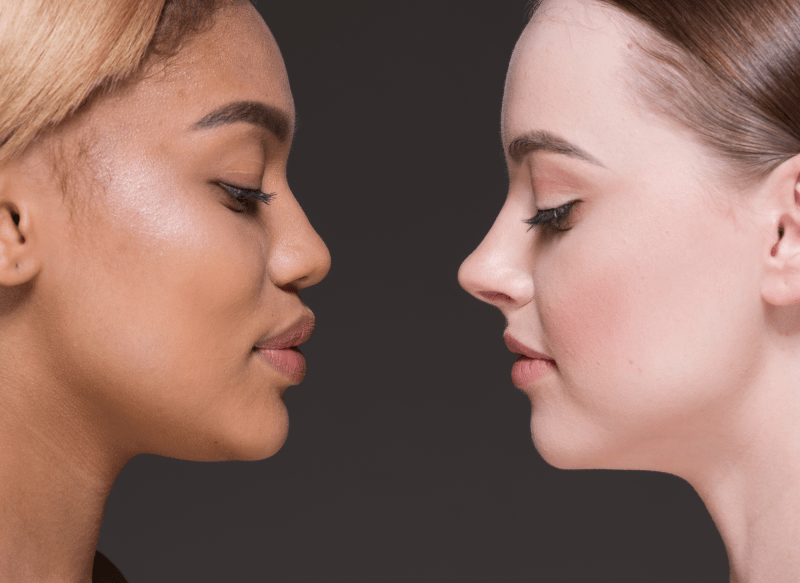
Which Anesthesia Method Is Applied During The Surgery?
Rhinoplasty surgeries are predominantly performed under general anesthesia to ensure the patient’s comfort and safety throughout the procedure. General anesthesia allows the patient to be completely asleep during the operation and not feel any pain, which enables the surgeon to work continuously and precisely without any interruption. Although some very minor interventions (e.g., only nasal tip aesthetics) can be performed under local anesthesia and sedation, general anesthesia remains the most common and safest option for comprehensive rhinoplasty procedures. The anesthesiologist will evaluate your general health status to determine the most appropriate method for you.
How Does The Post-Operative Recovery Process Work?
The recovery process after rhinoplasty progresses gradually over time. The first week is the period when a cast or splint is worn, and there is significant swelling in the nose and surrounding areas. Bruising usually decreases significantly within the first 10 days, allowing the patient to resume light activities. After the cast is removed, the nose begins to take its new shape, but swelling persists. Patients can generally return to their daily routines within one week, but intense physical activity and heavy sports must be strictly avoided. The nose takes its final shape and the swelling completely subsides over a period of six months to one year.
Can Nasal Obstruction Be Corrected With Rhinoplasty?
Yes, rhinoplasty does not only have to be an aesthetic procedure; structural problems causing nasal obstruction can also be corrected during the same surgery. Conditions that make breathing difficult, such as a deviated nasal septum or the enlargement of nasal turbinates (concha hypertrophy), can be permanently resolved with septoplasty and concha reduction procedures performed in conjunction with rhinoplasty. These combined procedures aim to provide both a better nasal appearance and healthy respiratory function. Your surgeon will thoroughly diagnose the origin of your breathing problem and plan the appropriate corrective steps.
When Does Swelling After Rhinoplasty Subsides?
Swelling that occurs after rhinoplasty subsides in two main stages. The initial and most significant swelling largely decreases when the splint and internal dressings are removed within the first week after the surgery. Subsequently, the majority of the remaining edema and swelling disappears within one to three months. However, the subtle swelling in the area of the nasal tip, which has the thickest skin, can take anywhere from six months to a year to fully resolve and for the nose to fully settle. Applying cold compresses as directed by your doctor and consistently using nasal taping helps to speed up this process effectively.
When Is The Final Shape Of The Nose Seen?
The final shape of the nose is seen when the swelling has completely subsided, which typically occurs at the end of one year, though this varies from person to person. This period may be slightly longer, especially for patients with thicker skin or those undergoing revision rhinoplasty. A significant aesthetic difference is observed even within the first few months, but patience is required for the edema to fully dissipate and for the internal structures to fully stabilize. Your surgeon will inform you about how your nose will look during different stages of the recovery process and will monitor your progress through regular check-ups.
How Long Should Sports Be Avoided After Rhinoplasty?
The time it takes to resume sports and intense physical activity after rhinoplasty is crucial for the safe and successful outcome of the surgery. As a general rule, heavy cardio, weightlifting, or contact sports that increase blood pressure and increase the risk of nasal bleeding should be strictly avoided for at least six weeks. Light walking and daily routine activities can be resumed a few days after the surgery. Protecting the nose from impact is of vital importance during the first month after the operation to ensure the delicate internal structures heal correctly.
What Are The Risks And Possible Complications Of The Surgery?
Like any surgical procedure, rhinoplasty involves certain risks and possible complications, but these risks are minimized with modern techniques and experienced surgeons who prioritize safety. Potential complications may include infection, bleeding, reactions to anesthesia, temporary numbness around the nose, asymmetry, or dissatisfaction with the final aesthetic outcome. Very rarely, persistent breathing problems or the necessity for a revision surgery may arise. Before the operation, your surgeon will explain these risks in detail and inform you about the precautions that must be taken for a healthy and optimal recovery process.
What Should Be Considered For Post-Operative Care?
Post-operative care is critical for the success of the recovery process. Keeping your head elevated while sleeping for the first few days helps reduce swelling and bruising. It is important to regularly use the prescription pain relievers and antibiotics provided by your surgeon. Saline nasal sprays applied inside the nose help with nasal cleansing and moisturizing. Until the cast or splint is removed, the face should not be soaked during bathing, and the nose must strictly not be touched or bumped. Strictly following all your surgeon’s instructions guarantees the healthiest possible final outcome.
Is Tampon Use Necessary And Is It Painful?
In modern rhinoplasty techniques, most surgeons prefer to use thin, silicone, or dissolvable splints that allow breathing, or opt not to use traditional gauze packing at all, which are outdated and uncomfortable. Tampon use is usually only necessary to control bleeding when additional functional corrections, such as septal deviation correction, are performed. The removal of new-generation silicone splints is significantly less uncomfortable than old-style gauze tampons, and some feel no pain at all. While mild discomfort may be felt after the surgery, it can be easily managed with prescribed pain medication.
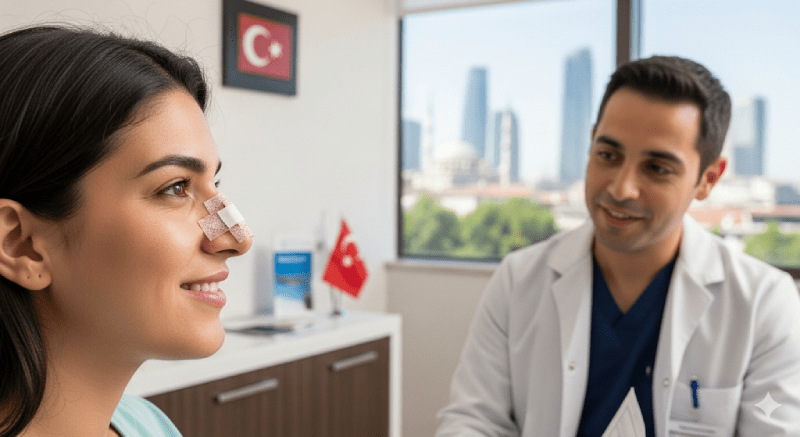
How Do Travel Expenses To Kusadasi Affect The Total Cost?
Although travel expenses (airfare) to Kusadasi are part of your overall treatment cost, thanks to the price advantage offered by surgical procedures in Turkey, the total cost often remains more affordable than the price in the patient’s home country, even for international visitors. Airfare prices may vary depending on the season and the time of booking. Cure Holiday assists in controlling your budget by including accommodation and transfers in your rhinoplasty package, ensuring that you only need to purchase your flight ticket to complete the entire process successfully.
How Should The Nose Be Protected From Sunlight After Rhinoplasty?
Protecting the nose from the sun is vital after rhinoplasty because the nasal skin will be sensitive and more vulnerable to sun exposure for some time. Sun exposure can increase swelling, cause bruising to become permanent, or lead to unwanted pigmentation (color change) on the skin, damaging the long-term result. Therefore, using high-factor sunscreen and wearing wide-brimmed hats is strongly recommended for the first six months. Considering the intense sunshine in Kusadasi, it is crucial to avoid direct sun exposure during the active healing period to ensure optimal results.
Are Nasal Tip Aesthetic (Tipplasty) Prices More Affordable?
Yes, as a general rule, only nasal tip aesthetic (Tipplasty) procedures are more affordable than full rhinoplasty procedures, which involve more complex structural corrections to the nasal bone or septum. Tipplasty involves limited interventions such as lifting, refining, or shaping the nasal tip and can often be performed under local anesthesia rather than general anesthesia. Since it is a shorter surgical procedure and involves a less extensive correction, the cost and recovery time for these specific tip procedures are generally lower than a full rhinoplasty, making it a very popular choice for minor fixes.
How Is The Process For International Patients In Kusadasi?
The rhinoplasty process for international patients in Kusadasi usually begins with the initial online consultation. The patient shares photos and medical history to receive a preliminary assessment and price quote from the specialist. Upon arrival in Kusadasi, they are met at the airport and transferred to their accommodation. The operation is performed after final pre-operative checks. After discharge, it is usually necessary to stay in Kusadasi for seven to ten days for the final check-ups, such as the removal of the splint and bandages. Cure Holiday provides translator and personal assistance services during all these stages to ensure you manage the process smoothly and without language barriers.
Does Insurance Cover Rhinoplasty Costs?
Since rhinoplasty is largely considered an aesthetic surgical procedure, the costs are not covered by private health insurance or social security institutions in most cases. However, if the surgery is performed to correct a medically necessary functional problem, such as a deviated nasal septum, the cost of the functional part of the operation may be partially or fully covered by insurance. When aesthetic and functional corrections are performed together (septorhinoplasty), you need to check in advance whether your insurance will only cover the functional component of the procedure.
Which Is The Best Season For Rhinoplasty In Kusadasi?
The most suitable season for rhinoplasty is generally autumn and winter months. The main reason for this is the necessity of protecting the swelling and edema from sunlight during the healing process. In sunny and hot weather, an effect that can increase the pressure on the nose may occur, and sun protection becomes more challenging. Having the surgery during the winter months allows the patient to spend the recovery period more comfortably and enables the nasal shape to largely settle before the summer season arrives. However, with proper protection in modern hospitals, rhinoplasty can be safely performed in any season of the year.
When Is The Use Of Glasses Allowed After Rhinoplasty?
The use of glasses after rhinoplasty is a topic that requires great caution to ensure the complete healing of the nasal bone and cartilage structures and the preservation of the new shape. Patients are generally advised to avoid wearing glasses for two to three months to prevent the frame from putting pressure on the sensitive areas of the nose. Patients with optical lenses are recommended to use contact lenses during this period or to secure lightweight framed glasses with tape so they do not rest directly on the nasal bridge. It is crucial to strictly follow your surgeon’s specific instructions on this matter.
Are The Results Of The Surgery Permanent And Do They Change With Age?
The results of rhinoplasty surgery are permanent because the nasal bone and cartilage structures are surgically reshaped. The cartilage and bone removed or restructured do not return to their original state. However, like all living tissues, the nose is affected by the aging process; natural processes such as gravity, the skin’s gradual loss of elasticity over time, and cartilage weakening may cause the nasal tip to slightly droop or the nasal skin to change. These changes are generally minimal, and the core shape provided by the surgery is preserved for many years, offering long-term satisfaction.
What Should Be Considered Before Having Aesthetic Surgery?
The most important thing to consider before having aesthetic surgery is to have realistic expectations; it is crucial to understand that rhinoplasty will not completely change your face, but only improve and enhance it within the natural limits of your features. The choice of surgeon is critical for the success of the procedure; you must choose a highly experienced and specialized surgeon in the field of facial aesthetics. Stopping smoking and the use of blood-thinning medications before the operation is essential for a healthy recovery. Furthermore, you must transparently share your entire medical history and all allergies with your chosen surgeon.
Are Payment Options And Installment Opportunities Available?
Health tourism centers in Kusadasi and intermediary institutions like Cure Holiday may offer various options to facilitate payments for international patients. These options typically include bank transfer, credit card payment, or paying a deposit upfront and the remainder upon arrival. Installment opportunities may differ or be limited for foreign credit cards, as they are generally subject to Turkish financial regulations. It is beneficial to inquire about all payment alternatives in detail during the reservation stage to finalize your payment plan securely.
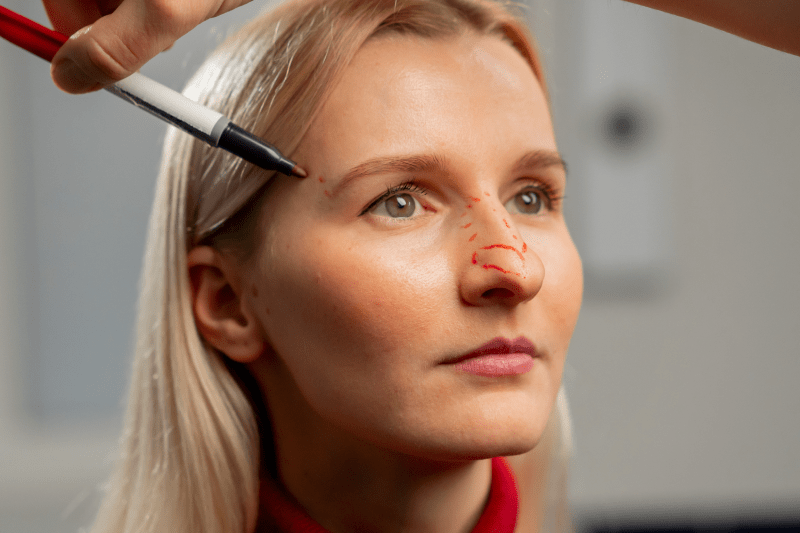
Why Is Smoking And Alcohol Consumption Forbidden Before Rhinoplasty Surgery?
Smoking and alcohol consumption are strictly forbidden before rhinoplasty surgery because they negatively affect surgical risks and the healing process. Smoking lowers the oxygen level in the body, impairs blood circulation, and this severely slows down wound healing, potentially increasing the risk of skin loss. Alcohol, on the other hand, thins the blood, significantly increasing the risk of bleeding during and after the operation, which can complicate recovery. Surgeons require smoking and alcohol to be completely stopped at least two weeks before the surgery; adhering to this rule is vital for a successful outcome and a rapid recovery.
How Should Nutritional Habits Be After Rhinoplasty?
Nutritional habits after rhinoplasty should be adjusted to support recovery. During the first few days, soft, warm foods that are easy to chew should be preferred due to the sensitivity in the nose and jaw area. It is important to avoid foods high in salt and sugar to prevent increasing swelling and edema. Plenty of fruits, vegetables, and fluids should be consumed to support adequate intake of protein, vitamins (especially Vitamin C), and minerals, which are crucial for tissue repair. Emphasizing fiber-rich foods to prevent constipation also helps minimize straining during the recovery period.
Are Pre- And Post-Operative Consulting Services Included In The Fee?
As a standard practice of health tourism packages in Kusadasi, comprehensive consulting services offered before and after the operation are generally included in the package price. These services include initial remote consultations, digital design work to finalize the shape, anesthesiologist evaluations, and post-operative wound care, splint removal, and long-term follow-up examinations. Cure Holiday provides a dedicated support line and assistant service to ensure that there is no communication breakdown during the entire process and that all your questions can be answered instantly, guaranteeing continuous support.
Can A Natural Appearance Be Achieved With Rhinoplasty?
Yes, one of the most important goals of modern rhinoplasty techniques is to achieve a natural-looking, harmonious with the face, and unoperated appearance that complements the patient’s existing features. A successful surgeon aims to improve not only the shape of the nose but also the overall harmony of the face by considering the patient’s facial features, skin thickness, and general aesthetic structure. Three-dimensional simulations performed before the surgery help the patient gain a realistic idea of the achievable outcome and support the goal of achieving a beautifully natural final appearance.
What Should I Consider In Kusadasi For Nose Surgery?
When choosing Kusadasi for nose surgery, you should primarily pay attention to the compliance of the health facility you will receive service from with international standards (e.g., JCI accreditation). Furthermore, you must clarify the content of the treatment package offered to you (accommodation, transfer, post-operative care). Most importantly, you should thoroughly research your surgeon’s experience in the field of rhinoplasty, their degree of specialization, and their previous patient results. Cure Holiday guarantees to connect you with centers that meet these high standards, ensuring safety and quality alongside affordable pricing.
Can Non-Aesthetic Medical Nasal Problems Be Resolved With Rhinoplasty?
Yes, non-aesthetic medical problems such as difficulty breathing can also be resolved concurrently with aesthetic rhinoplasty. The most common medical problems are a deviation in the central wall of the nose (septum deviation) and the excessive enlargement of the nasal turbinates (conchae). These conditions are permanently corrected with septorhinoplasty or septoplasty procedures performed during the same surgical session. Functional corrections open the airway, allowing the patient to breathe more easily, improving sleep quality, and potentially reducing sinus issues, thereby significantly enhancing their overall quality of life.
